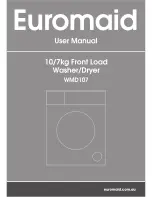
4
GB
Cleaning the pump
The washing machine is fitted with a self-clea-
ning pump which does not require any mainte-
nance. Sometimes, small items (such as coins
or buttons) may fall into the pre-chamber which
protects the pump, situated in its bottom part.
!
Make sure the wash cycle has finished and
unplug the appliance.
To access the pre-chamber:
1. using a screwdri-
ver, remove the cover
panel on the lower
front part of the wa-
shing machine
(see
figure);
2. unscrew the lid
by rotating it anti-
clockwise
(see figu-
re)
: a little water may
trickle out. This is
perfectly normal;
3. clean the inside thoroughly;
4. screw the lid back on;
5. reposition the panel, making sure the hooks
are securely in place before you push it onto
the appliance.
Checking the water inlet hose
Check the inlet hose at least once a year. If
there are any cracks, it should be replaced
immediately: during the wash cycles, water
pressure is very strong and a cracked hose
could easily split open.
!
Never use second-hand hoses.
Care and maintenance
Cutting off the water and electri-
city supplies
• Turn off the water tap after every wash cycle.
This will limit wear on the hydraulic system in-
side the washing machine and help to prevent
leaks.
• Unplug the washing machine when cleaning
it and during all maintenance work.
Cleaning the washing machine
• The outer parts and rubber components
of the appliance can be cleaned using a soft
cloth soaked in lukewarm soapy water. Do not
use solvents or abrasives.
• The washing machine has a auto clean pro
-
gramme for its internal parts that
must be run
with no load in the drum
.
To help the wash cycle you may want to use
either the detergent (i.e. a quantity 10% the
quantity specified for lightly-soiled garments)
or special additives to clean the washing
machine. We recommend running a cleaning
programme every 40 wash cycles.
To activate the programme, press the but-
ton for 5 seconds then press START/PAUSE
to start the programme, which will last roughly
70 minutes.
Cleaning the detergent dispenser
drawer
Remove the dispen-
ser by raising it and
pulling it out
(see
figure).
Wash it under running
water; this operation
should be repeated
frequently.
Caring for the door and drum of
your appliance
• Always leave the porthole door ajar in order
to prevent unpleasant odours from forming.
1
2
Summary of Contents for RPD 1066 D
Page 25: ...25 GR 26 27 28 29 30 31 32 33 34 35 36 GR RPD 1165 D...
Page 26: ...26 GR 1 3 4 gas 2 3 1 2 3 4 4 5 1 2 2...
Page 28: ...28 GR 10 40 5 70 1 2 3 4 5 1 2...
Page 29: ...29 GR 8 2012 19 EU 1 2 3 4 5 20...
Page 31: ...31 GR A B C D E F X Y Z G H I G L M X Y Z 1 H G Y X Z I L M A B C C D E C F...
Page 32: ...32 GR 1 HOTPOINT 2 3 4 5 6 2 40 3 90 4 60 h 1 2 3 3 40 40 3 7 8 Direct In jection...
Page 35: ...35 GR F 01 F ON OFF 65 100 cm 1...
Page 36: ...36 GR Mod S N...
Page 49: ...49 50 51 52 53 54 55 56 57 58 59 60 RPD 1165 D...
Page 50: ...50 2 1 3 4 2 3 1 2 3 4 4 5 1 2...
Page 52: ...52 a 10 40 5 70 1 2...
Page 53: ...53 8 1 19 EU 20...
Page 55: ...55 A B C D E F G H I G L M X Y Z 1 H G Y X Z I L M A B C C D E C F...
Page 56: ...56 HOTPOINT 2 40 3 90 4 60 h 1 2 3 40 40 c c 3...
Page 59: ...59 ON OFF...
Page 60: ...60...
Page 62: ...62 RU 1 2 3 4 5 1 2 2 1 3 4 gas 2 3 63 c...
Page 64: ...64 RU 10 40 5 70 1 2 3 4 5 1 2...
Page 65: ...RU 65 8 1 19 EU 80 20...
Page 67: ...RU 67 A B C D E F X Y Z G H I G L M X Y Z 1 H G Y X Z I L M A B C C D E C F...
Page 68: ...68 RU 1 HOTPOINT 2 3 4 5 6 2 40 3 90 4 60 h 1 2 3 3 40 C 40 C 3 7 8 Direct Injection...
Page 71: ...RU 71 F 01 F ON OFF 65 100 1...





































